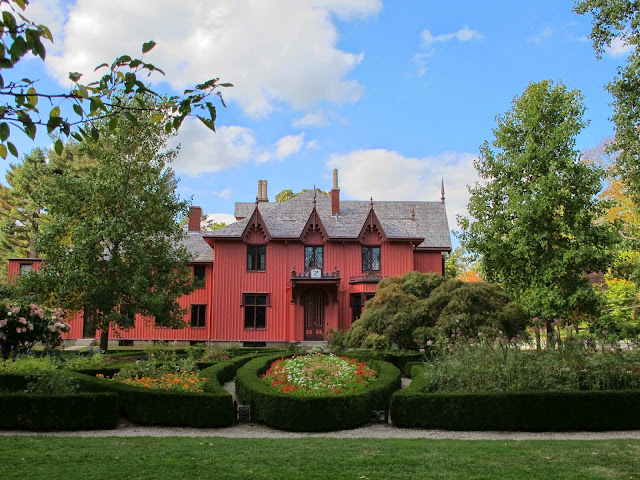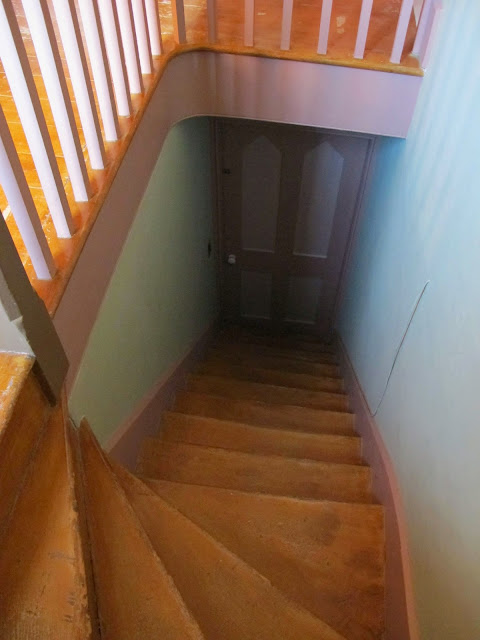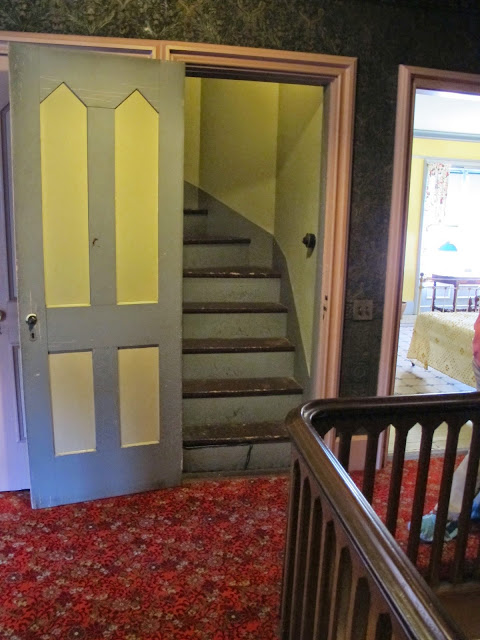This is Henry Chandler Bowen (1813-1896), capitalist, publisher, philanthropist, friend of presidents. What is it about this man's face that makes me not want to trust him?
Here is Mrs. Bowen, or more correctly the first Mrs. Bowen, nee Lucy Tappan. During 19 years of marriage she bore Mr. Bowen 10 children, resigning the post in 1863 following fatal complications from delivery of #10. Unfortunately, Lucy Bowen's simper, an affliction of much Victorian portraiture, doesn't speak much to her character. Within 2 years of her death, Bowen married Ellen Holt, who gave him yet another child (in 1868), and outlived him by 7 years. Bowen was a fervent proponent of abolition and Christian morality, attitudes his second wife shared with especial enthusiasm.
In 1845, flush with profits from his New York City silk business, 32-year-old Bowen hired English architect Joseph C. Wells (1814-1860) to build a country house in Woodstock, CT., the village of Bowen's birth. Wells gave the client a high fashion "Gothick" cottage, abristle with pointy arches, spear-like finials, vertiginous roofs, and board and batten siding, much in the mode of tastemaker Andrew Jackson Downing.
Bowen's silk business went under during the Civil War (his southern customers stopped paying), but he had already become rich in the fire insurance business and, more importantly, as proprietor of a hugely influential New York weekly called "The Independent," whose passionate anti-slavery editorials played an important role in America's march to civil war. President Lincoln proclaimed himself a regular reader. After the War, Presidents Grant, Harrison, Hayes and McKinley were all drawn into Bowen's orbit by his newspaper's irresistible mix of Christian morality and Yankee patriotism. Bowen's annual 4th of July blowouts at Roseland, starting in 1870, became so large that by 1876 he bought a nearby 60-acre parcel to accommodate overflow crowds and named it Roseland Park. The image below shows President Benjamin Harrison (with beard, seated in the middle) on the porch at Roseland during 1889's celebration. Also present on that porch were 2 cabinet members, an Associate Justice of the Supreme Court, the Speaker of the House of Representatives and 3 United States senators.
Common bonds in Congregationalism and abolition led publisher Bowen to hire as editor of The Independent a Brooklyn clergyman with a fast growing reputation named Henry Ward Beecher (1813-1887). Beecher's church, built in 1849, was also, probably not coincidentally, designed by Bowen's architect, Joseph Wells. In 1852 Beecher's sister, Harriet Beecher Stowe, published the biggest selling and most influential book of the 19th century (aside from the bible) titled, "Uncle Tom's Cabin, or Life Among the Lowly." Her like-minded brother's electrifying sermons transformed his small congregation at Plymouth Church into a 19th century "mega-church," and his wildly popular lecture tours arguably made him the most famous man in America. Beecher's view of God as an embodiment of love, as opposed the Puritans' perpetually angry diety, transformed American Christianity. Beecher also supported women's rights, condemned anti-semitism, championed evolution and didn't believe in hell. He rejected the previous generations' gloomy condemnations of pleasure as a distraction from holiness, observing (fatefully, as it would turn out) that "Man was made for enjoyment."
Summer at Bowen's Roseland was a drowsy succession of clean and moral activities - church-going, bible-reading, long walks, croquet, bowling....zzzzzz. Oh yes, and having a child every 18 months.
Roseland's interiors were redecorated in the mid-1880s with heavy emphasis on the first floor - "heavy" being the operative term. Stained glass, grander fireplace surrounds, oriental rugs, busy (busy busy!) wallpaper, furniture with involved carving and, most importantly, an abundance of Lincrusta, an elaborately stamped wall-covering made from a goop of gelled linseed oil and wood flour, made the place "interesting," as the Victorians liked to say. I've got Lincrusta on my walls at Millbrook, but nothing compared to this.
A few footnotes on the floor plan: Double parlors east of the main hall are fairly standard, but the "North Room" is not. Supposedly designed as a library - not, it would seem, for people who read very much - it was pressed into service as a bedroom for the growing Bowen brood. Adjacent to the North room is a ground floor bedroom occupied by the last family member to live in the house, Miss Constance Holt, who died 1968. At the west end of the building, the room labeled "Living Room" was probably the servant hall. The "Museum Office" was a laundry room, part of an 1870 addition with maids' rooms on the floor above.
Let's have a look at the double parlors and the small conservatory in between, all in spectacular condition and furnished with the Bowens' own things.
Miss Holt's room, while not as showy as others on the first floor, speaks eloquently to Victorian comfort
The North Room is thought to have been used in the last years of Miss Holt's life by a companion.
Let's walk back down the main hall to the front door, admire the amazing Lincrusta on the hall walls, and explore the dining room with it own Lincrusta.
A door on the west wall leads to a small serving pantry, beyond which is the kitchen. Happily, although presently used as office space, no one has felt the need to rip out old plumbing or junk the original stove.
The image below is presumably the former servant hall. Below it are images of the laundry room and a corridor that connects to the kitchen.
Time to go upstairs.
Second floor footnotes: The bath labeled 202 was originally Mr. Bowen's study; amusingly, his safe is still in it. 204 was his bedroom; 206 was that of his successive wives. The best guestroom, labeled "Presidents Chamber," is 201. Ten children presumably filled the rest of the second floor. I don't see any of the servants' rooms supposedly added in 1870. Some must have slept in the house, but where exactly, other than at the western end, I can't say.
My readers may be forgiven for not knowing much (or anything) about the famous 1875 trial of Henry Ward Beecher for, of all things, adultery. Talk about salacious, news reports of the proceedings practically banished Reconstruction from America's front pages for two and a half years. If we are to believe "The Most Famous Man in America: The Biography of Henry Ward Beecher" by Debby Applegate - and I for one am prepared to do so - the villain in this astonishing scandal, the man who betrayed the participants and orchestrated the whole thing was Henry Chandler Bowen. His bedroom, papered in green through the door on the left below, is a good place to start.
It all began in 1870. For years, the joke among those in the know was that every Sunday Henry Beecher preached to at least 7 or 8 of his mistresses. (Man, after all, was meant to enjoy himself). Nothing came of this until Beecher left The Independent to start his own magazine. His defection might not have seemed so inflammatory to some, but Bowen appears to have gone ballistic, in a serpent-like way. Having discovered Beecher's conquests included the wife of The Independent's soon to be fired replacement editor, Theodore Tilton, Bowen induced Tilton to write Beecher a letter of accusation demanding he resign his pastorship at Plymouth and leave Brooklyn immediately. Bowen himself delivered the letter, a week before he fired Tilton. To Bowen's dismay, however, Tilton and Beecher reached an agreement to hush things up. Or, such is one interpretation. There the matter might have languished, had Tilton himself not been sleeping with the remarkable Victoria Woodhull (1838-1927) to whom he confided the whole messy tale. Let's continue this in Mrs. Bowen's room.
Woodhull is remembered unkindly - and unfairly - as a charlatan who, together with her sister Tennessee, bamboozled Commodore Vanderbilt with crystal balls and table knocking. In point of fact, she was a free thinking feminist who played the stock market, believed in free love and birth control, published the first English translation of the "Communist Manifesto," ran (as opposed to actually campaigned) for president on the Equal Rights ticket, and hated hypocrisy. When Tilton told her that Beecher, the famous preacher who held forth each Sunday on the sanctity of marriage and the evils of adultery, was actually sleeping around himself, it was her turn to react ballistically. "Woodhull and Claflin's Weekly," her and her sister's platform for everything that annoyed them about hypocritical Victorian society, outed Beecher in the most sensational manner.
On to the Presidents Room, not that any of them had anything to do with any of this. Victorian prudery initially prevented the mainstream press from printing Woodhull's accusations, at least until Henry Bowen slyly mailed copies of her paper out of state. The result was Woodhull's arrest for sending obscene material across state lines, and that was a story the major papers could not ignore. Woodhull was acquitted and ended her life a rich widow in the English countryside. Beecher's 1875 trial ended in a hung jury, after which his career, reputation and finances made a 100% recovery. Only Tilton was ruined. As for Bowen, if his goal was to ruin Beecher, his motivations seem obscure, unless he knew more about Beecher's philandering than we do.
Let's return to the top of the stairs, explore the last bedroom in the main block of the house, and peek into the west wing.
Of course I wanted to see the attic, which my hostess at Historic New England completely understood. I have a feeling some of the servants slept up here. Until the very end of the 19th century, most big houses in America paid very little attention to the comfort of the help.
Here's the barn behind the house, notable for housing the oldest private bowling alley in America. As for Henry Bowen, I love discovering stories that conflict so satisfyingly with the usual treacly descriptions of historic house owners. He sounds perfectly awful, which makes him a much more interesting character. Since 1970 Roseland has been a property of Historic New England, among the region's best stewards of historic sites. The link is www.historicnewengland.org.




















































































Nice to see one of these Gothic "cottages" with the original interiors still intact. Quite wonderful really, not so much the patriarchal tyrant responsible for it.
ReplyDeleteThanks for this post! It's so great to be able to finally see the interiors of this place. It's one of those houses I always tell myself I must go and visit, but never get around to it. I'm not the least bit disappointed either. That exterior color is really jarring, it looks even more psychedelic here than it does in the other photos I've seen. I'd have to change that if I owned the house. I might have to rip some of that lincrusta out too. I hate to sound like a vandal, but that's a lot to take. I assume that would not have been original to the house in the 1840s anyway, right?
ReplyDeleteIt just occurred to me that Madame Jumel of the Morris-Humel mansion was born Eliza Bowen. Maybe she and Henry Chandler Bowen are kin, although I doubt he'd admit it if they were.
Another great post -- a highlight of my week. The inclusion of the floor plans is a great addition to your blogs. (I've noticed more of them lately.) . As for Miss Woodhull and the scandal mentioned, it gets great coverage in Other Powers: the Age of Suffrage, Spiritualism, and the Scandalous Victoria Woodhull, by Barbara Goldsmith. Thanks so much, John, for all you do!
ReplyDeleteLiked this house more than I thought I would! Suspect it would be as cold as its first owners heart in winter,though.
ReplyDeleteRemarkable interiors. Acres of lincrusta aside, which may have darkened with age, (thereby reinforcing stereotypes of Victorian decorating preferences), there are some really interesting features here. As much as one enjoys reading this blog for the social history, a little more design analysis wouldn't hurt, and a few of the fireplace mantels I think deserve special mention. It's a little hard to tell from the photographs but the one in the Front Parlor festooned with girandoles may be of fleur-de-peche marble. There's another in the dining room that appears to be a happy hybrid of Portoro and Egyptian marbles, very much in the late Greek Revival manner and an indication that in matters of stylistic consistency, at least, neither architect nor client were particularly strict. That blue, gold and white enamel door hardware is really lovely, but it doesn't get a chance to stand out among all the competition for our attention in this house.
ReplyDeleteAnd that group photo! I know there's a tradition of grappling among posing undergraduates, but what's going on with the oddly matched pair to the left of the President? Just where is that beardless youth's elbow burrowing, and why?
ReplyDeleteThe president is actually the white-bearded fellow further back in the group. As for the beardless youth's elbow, it is either where it shouldn't be at all, or where it's already been before.
Deletemagnificent Gothic Revival design, truly amazing that it has survived intact with all of it's Victorian interior elements as well preserved as they are. Ripping out any of that magnificent late 19th century lincrusta would be a preservation crime. Wonderful post on a well maintained and cared for historic home. If only all preservation groups had the time, resources and obvious funding to be such great stewards.
ReplyDeleteFascinating with all those Gothic details and fashionably gloomy inside to boot. There is some lovely furniture in those parlors. I've always imagined that Lincrusta must attract a lot of dust in all those little crevices but it was popular (and durable) in its day. That peeling attic wallpaper in the Japanesque taste of the 1880s is great.
ReplyDeleteThe Woodhull sisters would be great subjects for a juicy costume movie what with all the table rapping, free love, and beguiling old Commodore Vanderbilt. Or maybe a Broadway musical?
Your ideas inspired me Thank you very much.
ReplyDeleteA must read post! Appreciating the hard work you put into your site and detailed!
ReplyDeleteI like the helpful info you provide in your articles.
ReplyDelete